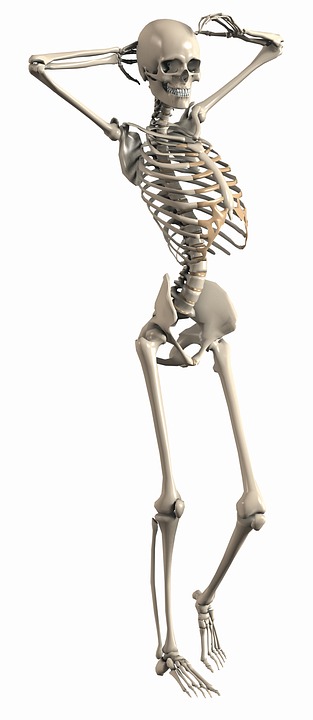The key difference between exoskeleton and endoskeleton is that the exoskeleton is an external skeleton present outside the body of an animal while the endoskeleton is an internal skeleton present inside the body of an animal.
Body of a living organism, be it a honey bee or a human being, is a complex network of different organs. These organs perform several functions of their own besides being connected to each other for a harmonious, balanced and functional body. All are complex marvels of nature as every species has a special feature of its own. Some have only an endoskeleton while some have only an exoskeleton while some have both for support. As the name suggests, exoskeleton locates outside the body while endoskeleton locates inside the body. The external skeleton protects and also supports the animal’s body. On the other hand, endoskeleton gives support and protection to both the inner softer and fragile organs like heart, lungs, and kidneys, etc.
CONTENTS
1. Overview and Key Difference
2. What is Exoskeleton
3. What is Endoskeleton
4. Similarities Between Exoskeleton and Endoskeleton
5. Side by Side Comparison – Exoskeleton vs Endoskeleton in Tabular Form
6. Summary
What is Exoskeleton?
Exoskeleton is an external shell-like structure that is present outside the body of an animal. It is mainly a non-living structure derived from the ectoderm. The fossil record of mineralized exoskeleton came to light around 550 million years ago. It is very resistant, rigid, somewhat brittle and hard structure that has several specific roles to play.

Figure 01: Exoskeleton
Exoskeleton mainly helps in excreting waste products produced inside the body of an animal or an anthropoda. Furthermore, it supports the movement and safety of inner softer organs. Not only that, but exoskeleton also involves sensing and feeding. It contains calcium carbonate and/or chitin. In simple language, it is called a shell. Organisms like snails, crabs, lobsters, shellfish cockroaches, crustaceans and insects like grasshoppers have an exoskeleton and some animals like tortoise have both endoskeleton and exoskeleton.
What is Endoskeleton?
Endoskeleton is the mineralized tissue that gives support to the internal structure of an animal. It develops in deeper body tissues and organs. During the embryonic development, endoderm develops from mesodermal tissue and forms by notochord and cartilage. Later during the rest of intrauterine life or fetal life, this goes through stages of intra-membranous ossification and extra-membranous ossification, which finally leads to a network of bones, cartilage and secondary cartilage. Eventually, all these combine to form an endoskeleton.

Figure 02: Endoskeleton
There are different forms and types of endoskeletons that differ with regard to development and complexity. Hence, the endoskeletons of Chordata, Coleoidea, Porifera, and Echinodermata differ from each other. Similar to the exoskeleton, endoskeleton also has specific roles such as support, protection, etc. Furthermore, endoskeleton supports the locomotion and the movements of body parts, while serving as attachment sites for the muscles.
What are the Similarities Between Exoskeleton and Endoskeleton?
- Exoskeleton and Endoskeleton are hard structures that provide structural support to the body of an organism.
- Also, both have some similar functions like support, movement and protection.
- Most importantly, both skeletons protect the internal organs of the animals.
What is the Difference Between Exoskeleton and Endoskeleton?
In short ‘endo’ means part of the body that is inside and ‘exo’ means part of the body that is outside in this particular matter. Hence, this is the main difference between exoskeleton and endoskeleton. Endoskeleton is what we humans have while exoskeleton is what insects and other arthropods have. Furthermore, the exoskeleton helps in excretion, but endoskeleton does not.
Similarly, another difference between exoskeleton and endoskeleton is that the endoskeleton has bone marrow in the shaft of long bones that helps in making blood cells by the process of endothelial proliferation for the body, while this feature is not present in exoskeleton. Moreover, exoskeleton mostly contains the non-living portions of the body for example scales on fish, hair on most animals, horns, feathers on birds but the inside of this feather to which muscle is attached, the hard part is the endoskeleton and is the living portion of the body which respond to stimuli from the brain. Hence, this is also an important difference between exoskeleton and endoskeleton. Also, in terms of development, endoskeleton develops from mesoderm or endoderm and exoskeleton from ectoderm.

Summary – Exoskeleton vs Endoskeleton
Exoskeleton and endoskeleton differ mainly from each other by the location of the body where it situates. Exoskeleton is present external to the body while endoskeleton is present inside the body. Thus, this is the key difference between exoskeleton and endoskeleton. Furthermore, they differ from the germ layer from which they derive. Exoskeleton is derived from the ectoderm while endoskeleton is derived from the endoderm or mesoderm. And also, exoskeleton is a rigid structure which is nonliving while endoskeleton is a flexible structure which is living.
Reference:
1.Libretexts. “38.1: Types of Skeletal Systems.” Biology LibreTexts, Libretexts, 12 June 2018. Available here
Image Courtesy:
1.”Fiddler crab exoskeleton shedding within the marsh (6555236543)”By Pacific Southwest Region USFWS from Sacramento, US (Public Domain) via Commons Wikimedia
2.”2504344″ by anaterate (CC0) via pixabay
ncG1vNJzZmivp6x7pbXFn5yrnZ6YsqOx07CcnqZemLyue8OinZ%2Bdopq7pLGMm5ytr5Wau26x16iqpJ2cmsGwuoyapZ1lpqh6prrDqKqknZyawbC6jg%3D%3D